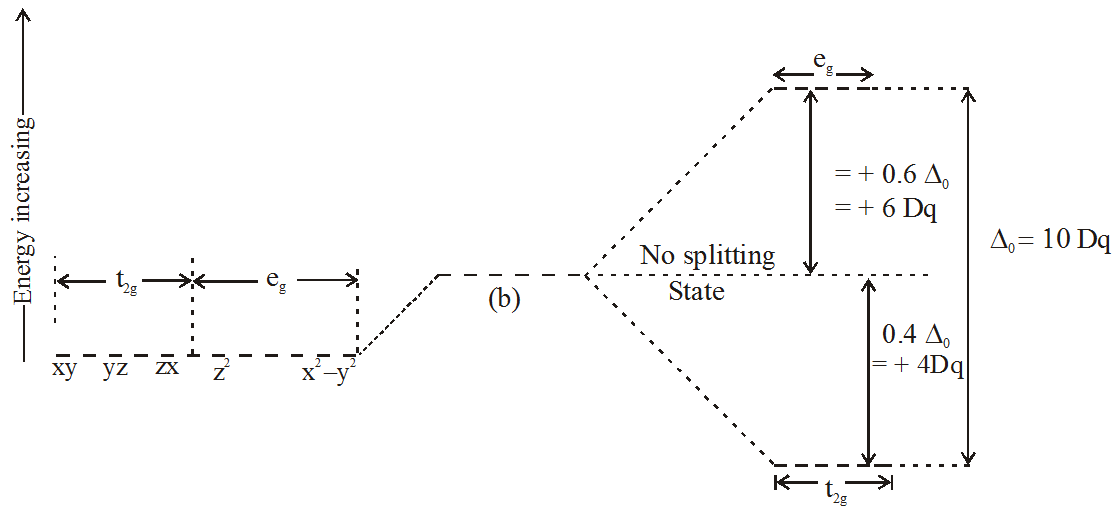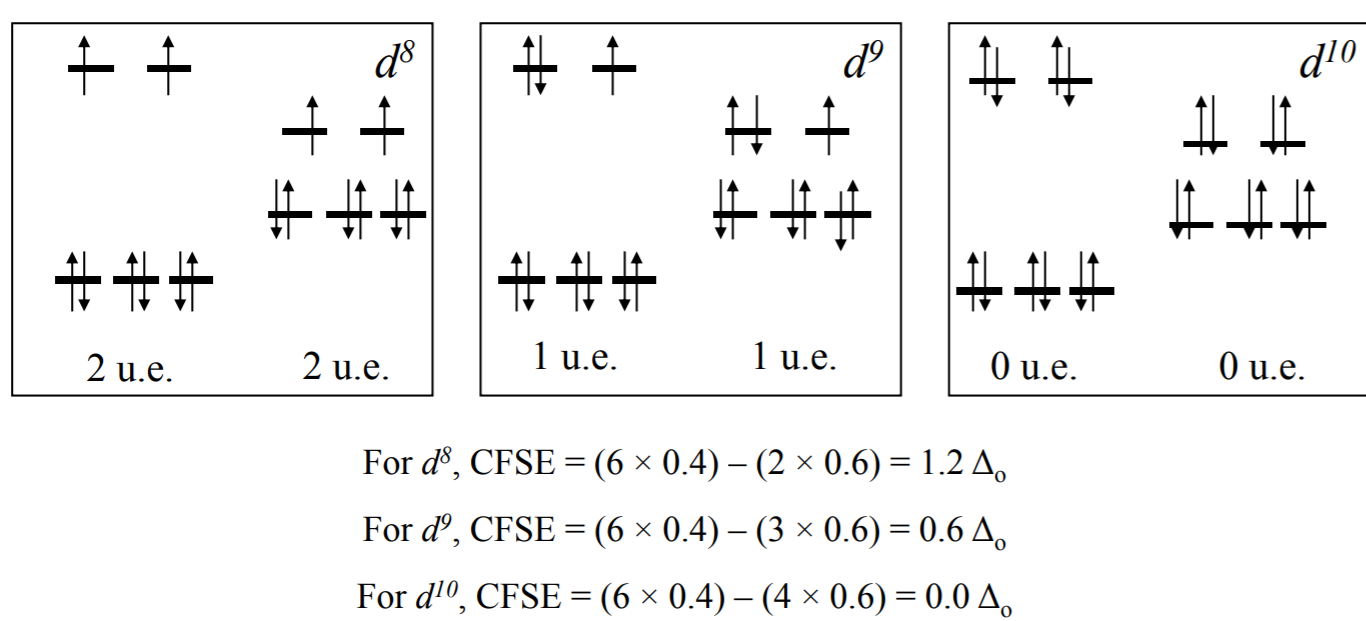
Strong field ligands,such as $$\mathrm{CN}^{-}$$ usually produce low spin complexes and large crystal field splitting.
If true enter 1, else enter 0.
Answer
480.3k+ views
Hint: Strong field ligands produce low spin complexes. This is due to the Crystal field theory. So, spin of a complex is directly proportional to how many electrons are unpaired in an orbital.These ligands help in pairing of the electrons.
Complete step by step answer:
Crystal field theory(CFT) was developed by H.Bethe and V.Bleck in 1935. This theory considered the bond between a metal ion and the ligand as purely electrostatic.
In coordination chemistry, a ligand is an ion or molecule that binds to a central metal atom to form a coordination complex.
CFT is based on the assumption that the metal ion and the ligands act as point charges and the interaction between them are purely electrostatic. In case of negative ligands like, Cl,CN,etc. the interaction with metal ions are ion-ion interactions. If the ligands are neutral like, CO,etc. The interaction with the metal ions are ion-dipole interactions. The name crystal field is assigned to this theory as the electrons of the central metal ion in the environment of other ions or molecules i.e.,ligands are affected by their non spherical electric field.
In this theory, we have to understand Crystal Field Stabilization Energy (CFSE) in order to answer the given question.

The phenomenon of crystal field splitting in an octahedral complex is illustrated here. The energy difference between two sets of d-orbitals; $$\mathrm{t}_{2 \mathrm{g}} \text { and } \mathrm{e}_{\mathrm{g}}$$ is called crystal field splitting energy and is symbolically represented as $$\Delta_{0}$$.
Now,in order to solve the given question we have to know about CFSE.
Crystal field stabilization energy(CFSE) is the amount of stabilization provided by splitting of the d-orbitals into two levels.
There are two possibilities for metal ions having $$\mathrm{d}^{4}-\mathrm{d}^{7}$$ electronic configuration. Depending on the nature of the ligands and the metal they could be high-spin or low 2 spin complexes. For the $$\mathrm{d}^{4}$$ system, CFSE = For high-spin, (3 × 0.4 ) – (1 × 0.6 ) = 0.6$$\Delta_{0}$$ and for low-spin, 4 × 0.4 = 1.6$$\Delta_{0}$$.
Metal ions with 4 to 7 electrons in the d orbital can exist as high spin or low spin complexes. Weaker ligands tend to give high-spin complexes, whereas stronger ligands tend to give low-spin complexes.


So, the correct answer is “1”.
Note: In case of strong field complexes, the complex has less number of unpaired electrons due to large crystal field splitting. These are called low spin complexes. Now coming to spin, when there are electrons unpaired in an orbital after making the complex which generally happens in case of weak field ligands(there are some exceptions too) the complex is of high spin which means spin of a complex depends on the number of unpaired electrons in an orbital. On the other hand when all the electrons are paired up generally happens in case of strong field ligands (There are exceptions also) the complex is of low spin.
Complete step by step answer:
Crystal field theory(CFT) was developed by H.Bethe and V.Bleck in 1935. This theory considered the bond between a metal ion and the ligand as purely electrostatic.
In coordination chemistry, a ligand is an ion or molecule that binds to a central metal atom to form a coordination complex.
CFT is based on the assumption that the metal ion and the ligands act as point charges and the interaction between them are purely electrostatic. In case of negative ligands like, Cl,CN,etc. the interaction with metal ions are ion-ion interactions. If the ligands are neutral like, CO,etc. The interaction with the metal ions are ion-dipole interactions. The name crystal field is assigned to this theory as the electrons of the central metal ion in the environment of other ions or molecules i.e.,ligands are affected by their non spherical electric field.
In this theory, we have to understand Crystal Field Stabilization Energy (CFSE) in order to answer the given question.

The phenomenon of crystal field splitting in an octahedral complex is illustrated here. The energy difference between two sets of d-orbitals; $$\mathrm{t}_{2 \mathrm{g}} \text { and } \mathrm{e}_{\mathrm{g}}$$ is called crystal field splitting energy and is symbolically represented as $$\Delta_{0}$$.
Now,in order to solve the given question we have to know about CFSE.
Crystal field stabilization energy(CFSE) is the amount of stabilization provided by splitting of the d-orbitals into two levels.
There are two possibilities for metal ions having $$\mathrm{d}^{4}-\mathrm{d}^{7}$$ electronic configuration. Depending on the nature of the ligands and the metal they could be high-spin or low 2 spin complexes. For the $$\mathrm{d}^{4}$$ system, CFSE = For high-spin, (3 × 0.4 ) – (1 × 0.6 ) = 0.6$$\Delta_{0}$$ and for low-spin, 4 × 0.4 = 1.6$$\Delta_{0}$$.
Metal ions with 4 to 7 electrons in the d orbital can exist as high spin or low spin complexes. Weaker ligands tend to give high-spin complexes, whereas stronger ligands tend to give low-spin complexes.


So, the correct answer is “1”.
Note: In case of strong field complexes, the complex has less number of unpaired electrons due to large crystal field splitting. These are called low spin complexes. Now coming to spin, when there are electrons unpaired in an orbital after making the complex which generally happens in case of weak field ligands(there are some exceptions too) the complex is of high spin which means spin of a complex depends on the number of unpaired electrons in an orbital. On the other hand when all the electrons are paired up generally happens in case of strong field ligands (There are exceptions also) the complex is of low spin.
Recently Updated Pages
Master Class 11 Economics: Engaging Questions & Answers for Success

Master Class 11 Business Studies: Engaging Questions & Answers for Success

Master Class 11 Accountancy: Engaging Questions & Answers for Success

The correct geometry and hybridization for XeF4 are class 11 chemistry CBSE

Water softening by Clarks process uses ACalcium bicarbonate class 11 chemistry CBSE

With reference to graphite and diamond which of the class 11 chemistry CBSE

Trending doubts
What are the elders in Goa nostalgic about class 11 social science CBSE

Define least count of vernier callipers How do you class 11 physics CBSE

Write the differences between monocot plants and dicot class 11 biology CBSE

Which of the following is not a feature of the election class 11 social science CBSE

The mass of oxalic acid crystals H2C2O42H2O required class 11 chemistry CBSE

How many squares are there in a chess board A 1296 class 11 maths CBSE




